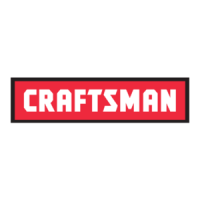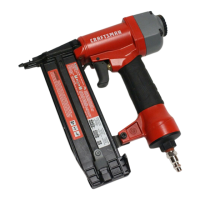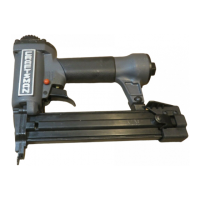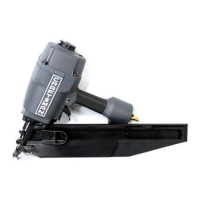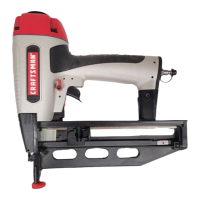CONTACT TRIP PAD
Refer to Figure 5 (page 6).
The tool is equipped with a contact trip pad (Fig. 5, No. 48)
that prevents marring of finished surfaces by the contact trip
during normal operation. The pad can be removed and stored
when it is not required.
CAUTION: Disconnect tool from air supply before removing or
reinstalling contact trip pad.
QUICK RELEASE NOSE
Refer to Figure 5 (page 6).
The tool is equipped with a quick release nose for clearing
jammed fasteners.
• If a fastener jams in the tool, disconnect the air supply
from the tool. Open the magazine and remove any fasten-
ers. Pull the nose cover latch (Fig. 5, No. 53) down and
release the nose cover. Remove the jammed fastener and
secure the latch. Reload the fasteners and reconnect the
air supply.
OPERATING PRESSURE
• Use only enough air pressure to perform the operation. Air
pressure in excess of that which is required will make the
operation inefficient and may cause premature wear or
damage to the tool.
• Determine minimum air pressure required by driving some
test fasteners into the workpiece. Set air pressure so that
test fasteners are driven down flush with the work surface.
Fasteners driven too deep may damage workpiece.
EXHAUST DEFLECTOR
Refer to Figures 4 & 5 (pages 4 and 6).
• Exhaust deflector can be positioned to point in any direc-
tion (full 360 ° movement). Reposition deflector (Fig. 5, No.
2) by grasping firmly and rotating to the desired position.
Rotate
Deflector
Refer to Figure 5 (page 6).
LUBRICATION
Lubricate tool daily with quality air tool oil. If no air line lubri-
cator is used, place five or six drops of oil into body (Fig. 5,
No. 36) through male quick disconnect of tool everyday.
MAGAZINE AND PISTON/RAM
• Keep magazine and contact trip area clean and free of any
dirt, lint or abrasive particles.
The tip of the ram (Fig. 5, No. 18) can become dented or
rounded over time.
• Square off the tip of the ram with a clean, fine hand file to
extend the life of the ram and tool. Fastener firing will be
more consistent if the ram tip is kept clean and square.
SAFETY MECHANISM
Inspect contact trip safety mechanism daily for proper opera-
tion. Do not operate tool if mechanism is not operating
properly.
With the switch (Fig. 5, No. 40) in the rapid-fire mode, perform
the following procedures to test safety mechanism:
• Leave trigger untouched while pushing contact trip into
workpiece. Tool must not fire.
• Pull trigger while contact trip is clear of work and pointed
away from operator and others. Tool must not fire.
• Depress and hold trigger. Push contact trip against work
where fastener is needed. The tool should drive only one
fastener each time the contact trip is pushed against
workpiece.
If contact trip mechanism does not operate properly,
repair tool immediately through Sears Service Center.
Replace any damaged or missing parts. Use the parts list to
order parts.
REBUILD KITS
Rebuild kits are available as spare parts, (see page 7). Tools
should be rebuilt if tool fails to operate properly after extended
use. See troubleshooting to determine required replacement
parts.
Disconnect tool from air supply before attempting repair
or adjustment.
NOTE: When replacing O-rings or cylinder, lubricate with air
tool oil before assembly.
Figure 4 - Exhaust Deflector Adjustment
4

